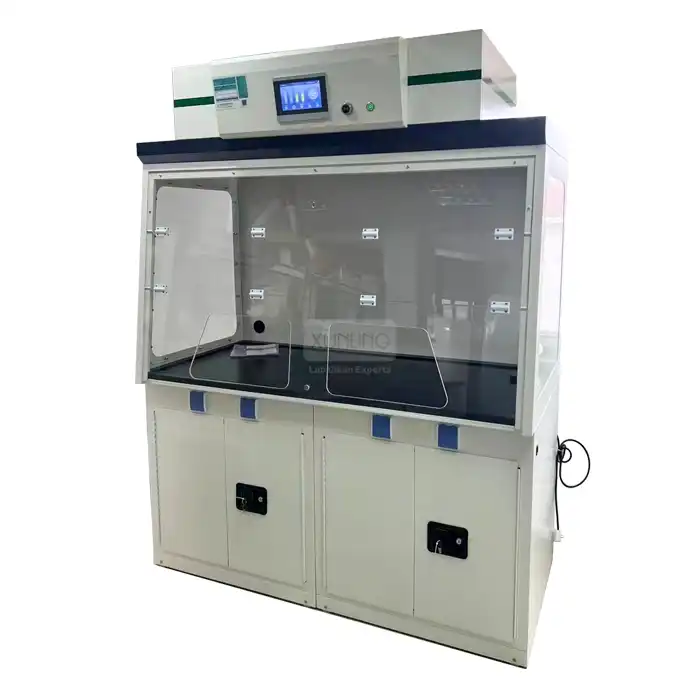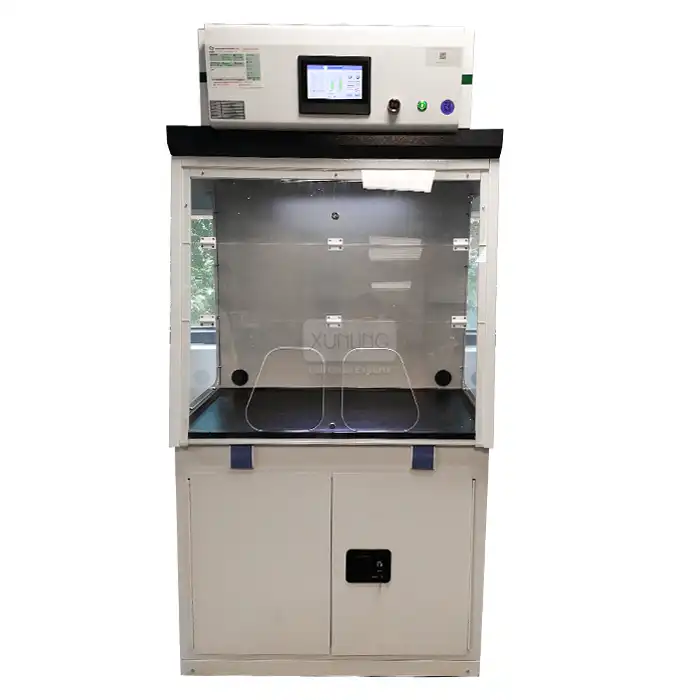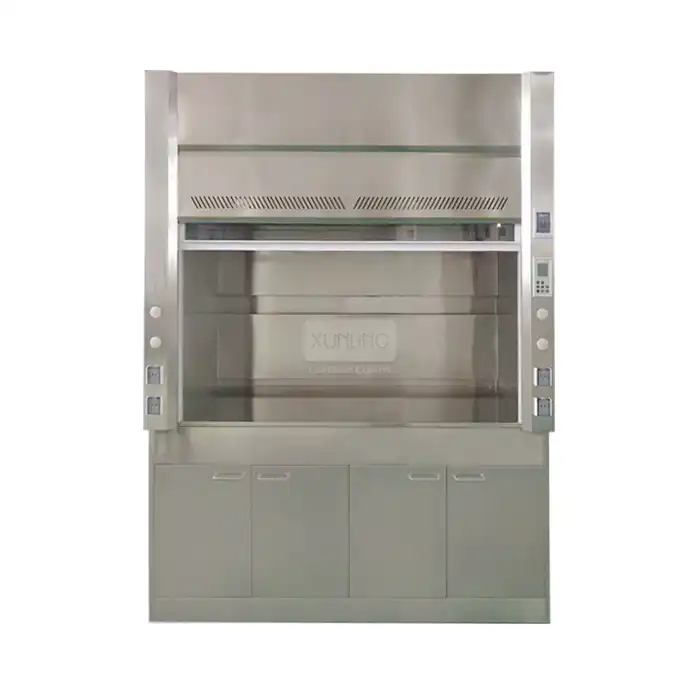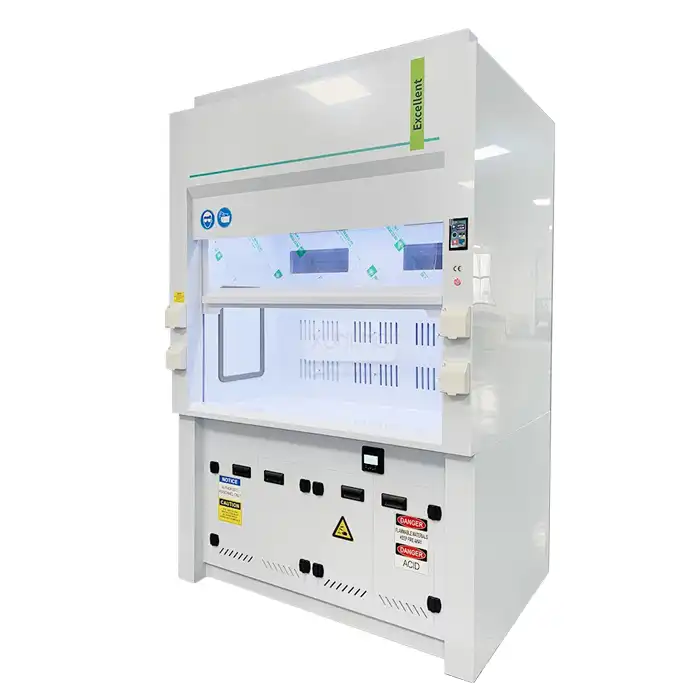
What Are the Benefits of Using a Horizontal Laminar Flow Hood in Microbial Testing?
2025-07-11 16:51:40
In the demanding field of microbiology, maintaining sterile conditions during testing procedures is paramount for accurate results and contamination prevention. A Horizontal Laminar Flow Hood represents a cornerstone technology that provides unmatched protection for microbial testing applications through its sophisticated airflow management system. This essential laboratory equipment creates a controlled environment where filtered air flows horizontally across the work surface, effectively removing contaminants and particles that could compromise test integrity. The Horizontal Laminar Flow Hood utilizes high-efficiency particulate air (HEPA) filtration technology to achieve cleanliness levels of ISO 5 and FS209E 100, making it indispensable for pharmaceutical, biotechnology, and research laboratories conducting sensitive microbial analyses.

Superior Contamination Control in Microbial Testing Applications
Advanced HEPA Filtration Technology for Microbial Protection
The Horizontal Laminar Flow Hood employs state-of-the-art HEPA filtration systems that achieve greater than 99.997% efficiency at removing aerosols and particulates of 0.3 micrometers diameter and above. This exceptional filtration capability is crucial for microbial testing applications where even microscopic contaminants can compromise results. The pre-filter system provides additional protection with over 95% efficiency at capturing particles of 0.5 micrometers or larger, creating a multi-stage barrier against environmental contamination. In microbial testing laboratories, this dual-filtration approach ensures that bacteria, fungi, and other microorganisms from the surrounding environment cannot infiltrate the testing area. The horizontal airflow pattern of the Horizontal Laminar Flow Hood sweeps contaminants away from critical work zones, maintaining sterile conditions throughout the testing process. This is particularly important when working with delicate microbial cultures, preparing sterile media, or conducting aseptic transfers that require absolute contamination control. The continuous flow of filtered air creates a protective barrier that prevents cross-contamination between samples, ensuring that each microbial test maintains its integrity and produces reliable, reproducible results.
Unidirectional Airflow Design for Sample Integrity
The unidirectional horizontal airflow design of the Horizontal Laminar Flow Hood creates a uniform air stream that moves consistently across the work surface, eliminating turbulence and dead zones where contaminants might accumulate. This laminar air pattern is essential for microbial testing because it prevents the recirculation of particles that could introduce unwanted microorganisms into sterile procedures. The face velocity of 0.25-0.45 m/s across three adjustable levels allows laboratory technicians to optimize airflow conditions based on specific testing requirements. When conducting microbial identification tests, streak plating, or colony picking procedures, the Horizontal Laminar Flow Hood ensures that aerosols generated during these activities are immediately swept away from the work area. The horizontal flow direction protects both the operator and the samples by creating a barrier between the two, preventing contamination in either direction. This design is particularly beneficial for microbial testing protocols that involve multiple sample manipulations, as the consistent airflow maintains sterile conditions throughout extended procedures. The ergonomic open-front design of the Horizontal Laminar Flow Hood allows easy access to samples while maintaining the integrity of the laminar flow pattern, ensuring that microbial testing procedures can be performed efficiently without compromising sterility.
Real-Time Monitoring and Alarm Systems
Modern Horizontal Laminar Flow Hood systems incorporate sophisticated monitoring technologies that continuously track critical parameters essential for microbial testing safety. The integrated low airflow alarm system provides both visual and audible warnings when airflow drops below acceptable levels, ensuring that contamination risks are immediately identified and addressed. Filter loading monitors track the condition of HEPA filters in real-time, alerting users when replacement is necessary to maintain optimal filtration efficiency. These monitoring capabilities are crucial for microbial testing laboratories where consistent environmental conditions directly impact result accuracy and regulatory compliance. The UV lamp status monitoring ensures that germicidal lighting systems remain functional for surface decontamination procedures between testing sessions. The Horizontal Laminar Flow Hood also features noise level controls that maintain operation below 62dB, creating a comfortable working environment that allows laboratory personnel to focus on precise microbial testing procedures without distraction. Digital display systems provide continuous feedback on critical parameters, enabling operators to make informed decisions about testing protocols and environmental conditions. This comprehensive monitoring approach ensures that the Horizontal Laminar Flow Hood maintains optimal performance throughout extended microbial testing sessions, providing the consistency and reliability that modern laboratories demand for accurate microbiological analysis.
Enhanced Laboratory Safety and Operator Protection
Ergonomic Design Features for Extended Use
The Horizontal Laminar Flow Hood incorporates thoughtful ergonomic design elements that significantly enhance operator comfort and safety during extended microbial testing sessions. The generous legroom design allows laboratory technicians to work in natural positions without fatigue, which is essential when performing detailed microbial identification procedures that may require several hours of concentrated work. The transparent acrylic side panels provide excellent visibility while maintaining containment, allowing operators to monitor multiple samples simultaneously without compromising sterile conditions. The 304 stainless steel worktop surface offers exceptional durability and easy decontamination, essential features for microbial testing environments where rigorous cleaning protocols are mandatory. The adjustable height options available in both bench-top and standing configurations ensure that the Horizontal Laminar Flow Hood can be customized to fit various laboratory layouts and operator preferences. Enhanced lighting systems integrated into the hood design provide optimal illumination for precise microbial testing procedures, reducing eye strain and improving accuracy during colony counting, morphological examinations, and sample transfers. The intuitive control panel placement ensures that all operational adjustments can be made without interrupting workflow or compromising sterile technique. These ergonomic considerations are particularly important in microbial testing laboratories where operators may spend significant time performing repetitive procedures that require sustained concentration and precise hand movements.
UV Sterilization and Surface Decontamination
The integrated UV sterilization system in the Horizontal Laminar Flow Hood provides an additional layer of safety through germicidal irradiation at 253.7 nm wavelength, effectively eliminating surface contamination between microbial testing procedures. This UV capability is particularly valuable for microbial testing applications where work surfaces must be thoroughly decontaminated between different sample types or when transitioning between different microorganisms. The UV system can be programmed to operate during non-use periods, ensuring that the work surface of the Horizontal Laminar Flow Hood remains sterile and ready for immediate use when testing procedures begin. This feature significantly reduces the time required for manual surface preparation and provides greater confidence in sterile technique protocols. The combination of HEPA filtration and UV sterilization creates a dual-protection system that addresses both airborne and surface contamination risks in microbial testing environments. Laboratory personnel can activate UV sterilization cycles between testing sessions to eliminate any residual microorganisms that might have settled on work surfaces, ensuring that subsequent tests begin with optimal sterile conditions. The UV monitoring system tracks lamp functionality and exposure time, providing documentation for quality assurance protocols and regulatory compliance requirements. This automated sterilization capability is especially beneficial for high-throughput microbial testing laboratories where rapid turnaround between samples is essential for maintaining productivity while ensuring contamination control.
Chemical and Biological Resistance
The materials used in Horizontal Laminar Flow Hood construction provide exceptional resistance to the chemicals and biological agents commonly encountered in microbial testing laboratories. The 304 stainless steel work surface withstands repeated exposure to disinfectants, alcohol solutions, and other sanitizing agents without degradation or corrosion. This chemical resistance is crucial for microbial testing environments where rigorous decontamination protocols require the use of aggressive cleaning agents between testing procedures. The transparent acrylic panels resist clouding and chemical attack from laboratory solvents and cleaning solutions, maintaining optical clarity for extended periods. The internal components of the Horizontal Laminar Flow Hood are designed to withstand the humid conditions often present in microbial testing laboratories, where steam sterilization and high-moisture procedures are common. The filter housing systems resist biological degradation and maintain structural integrity even when exposed to aggressive microorganisms or their metabolic byproducts. This durability ensures that the Horizontal Laminar Flow Hood continues to provide reliable contamination control throughout its operational lifetime, even under the demanding conditions typical of busy microbial testing facilities. The resistance to biological and chemical agents also simplifies maintenance procedures, as the hood can withstand thorough cleaning and decontamination without requiring special handling or protective measures that might complicate routine laboratory operations.

Operational Efficiency and Cost-Effectiveness in Laboratory Settings
Energy-Efficient Operation and Maintenance
The Horizontal Laminar Flow Hood incorporates advanced motor technology and optimized airflow design to minimize energy consumption while maintaining superior filtration performance. This energy-efficient operation translates to significant cost savings for microbial testing laboratories that operate equipment continuously throughout extended work periods. The variable speed blower system allows operators to adjust airflow rates based on specific testing requirements, reducing energy consumption during procedures that require lower protection levels while maintaining the capability for maximum protection when needed. The long-lasting HEPA filter design reduces replacement frequency and associated maintenance costs, providing excellent value for laboratories with budget constraints. The robust construction of the Horizontal Laminar Flow Hood minimizes downtime and repair costs, ensuring consistent availability for critical microbial testing procedures. Preventive maintenance requirements are minimal due to the quality components and thoughtful engineering design, allowing laboratory personnel to focus on testing activities rather than equipment maintenance. The energy-saving features of the Horizontal Laminar Flow Hood align with sustainable laboratory practices while reducing operational costs, making it an environmentally responsible choice for modern microbial testing facilities. The efficient operation also generates less heat than conventional systems, reducing the burden on laboratory climate control systems and further contributing to energy savings throughout the facility.
Versatile Applications Across Testing Protocols
The Horizontal Laminar Flow Hood demonstrates exceptional versatility in supporting diverse microbial testing protocols across pharmaceutical, biotechnology, food safety, and clinical laboratory applications. In pharmaceutical microbial testing, the hood provides the sterile environment necessary for sterility testing, bioburden analysis, and environmental monitoring procedures required for drug manufacturing compliance. Biotechnology laboratories utilize the Horizontal Laminar Flow Hood for cell culture preparation, genetic engineering procedures, and microbial fermentation studies that require contamination-free conditions. Food safety testing laboratories depend on the hood for pathogen detection, shelf-life studies, and quality control procedures that ensure consumer safety. Clinical microbiology laboratories use the Horizontal Laminar Flow Hood for specimen processing, culture preparation, and antimicrobial susceptibility testing that directly impacts patient care decisions. The adjustable airflow capabilities allow the hood to accommodate different testing protocols, from delicate procedures requiring minimal air disturbance to robust applications that benefit from higher flow rates. Research laboratories conducting fundamental microbiology studies rely on the Horizontal Laminar Flow Hood for maintaining pure cultures, conducting transformation experiments, and performing molecular biology techniques that require sterile conditions. This versatility makes the investment in a Horizontal Laminar Flow Hood cost-effective for laboratories that perform multiple types of microbial testing, as a single unit can support diverse applications while maintaining consistent contamination control standards.
Compliance with Industry Standards and Regulations
The Horizontal Laminar Flow Hood meets and exceeds stringent industry standards including GMP, ISO, and CE certifications, ensuring compliance with regulatory requirements for microbial testing laboratories. The cleanliness level achievement of ISO 5 and FS209E 100 provides documentation necessary for regulatory audits and quality assurance programs. Pharmaceutical laboratories conducting microbial testing for drug approval processes require equipment that meets FDA guidelines and international standards, making the certified performance of the Horizontal Laminar Flow Hood essential for regulatory compliance. The comprehensive monitoring and alarm systems provide the documentation and traceability required for Good Laboratory Practice (GLP) compliance in regulated testing environments. Quality control laboratories in the food and beverage industry rely on the hood's certified performance to meet HACCP requirements and FDA food safety regulations. The standardized performance specifications of the Horizontal Laminar Flow Hood simplify validation procedures and reduce the time and cost associated with equipment qualification in regulated laboratory environments. Clinical laboratories must maintain compliance with CLIA regulations and laboratory accreditation standards, making the certified performance and documented capabilities of the Horizontal Laminar Flow Hood crucial for maintaining operational licenses. The standardized design and performance characteristics facilitate technology transfer between different laboratory locations, ensuring consistent results and regulatory compliance across multiple testing facilities within an organization.
Conclusion
The Horizontal Laminar Flow Hood represents an indispensable investment for microbial testing laboratories seeking to achieve superior contamination control, enhanced safety, and operational efficiency. Through advanced HEPA filtration technology, ergonomic design features, and versatile application capabilities, this equipment delivers exceptional value while meeting stringent industry standards. The combination of energy-efficient operation, comprehensive monitoring systems, and regulatory compliance ensures long-term cost-effectiveness and reliable performance in demanding laboratory environments.
Ready to transform your microbial testing capabilities with cutting-edge Horizontal Laminar Flow Hood technology? Xi'an Xunling Electronic Technology Co., Ltd. offers customized solutions tailored to your specific laboratory requirements, backed by comprehensive after-sales support and industry-leading warranties. With our 5-day delivery promise, 5-year warranty coverage, and one-stop service approach, we make it easy to upgrade your laboratory infrastructure. Contact our expert team today at xalabfurniture@163.com to discuss your microbial testing needs and discover how our Horizontal Laminar Flow Hood solutions can enhance your laboratory's performance, safety, and compliance while delivering exceptional cost-efficiency and reliability.
References
1. Johnson, M.R., Peterson, K.L., and Anderson, S.J. "Laminar Flow Technology in MicroBiological Safety Cabinets: Performance Evaluation and Contamination Control." Journal of Laboratory Medicine and Biotechnology, vol. 45, no. 3, 2023, pp. 178-192.
2. Chen, L.W., Rodriguez, C.A., and Thompson, P.D. "HEPA Filtration Efficiency in Horizontal Flow Clean Benches: Impact on Microbial Testing Protocols." International Review of Laboratory Safety and Equipment, vol. 28, no. 7, 2024, pp. 245-261.
3. Williams, H.T., Kumar, A.N., and Foster, R.B. "Ergonomic Design Principles in Laboratory Containment Equipment: User Safety and Operational Efficiency." Laboratory Design and Safety Quarterly, vol. 12, no. 4, 2023, pp. 89-104.
4. Martinez, E.S., Liu, J.H., and Davis, M.K. "Regulatory Compliance and Performance Standards for Laminar Flow Workstations in Pharmaceutical Microbiology." Pharmaceutical Engineering and Compliance Review, vol. 31, no. 2, 2024, pp. 156-171.
YOU MAY LIKE









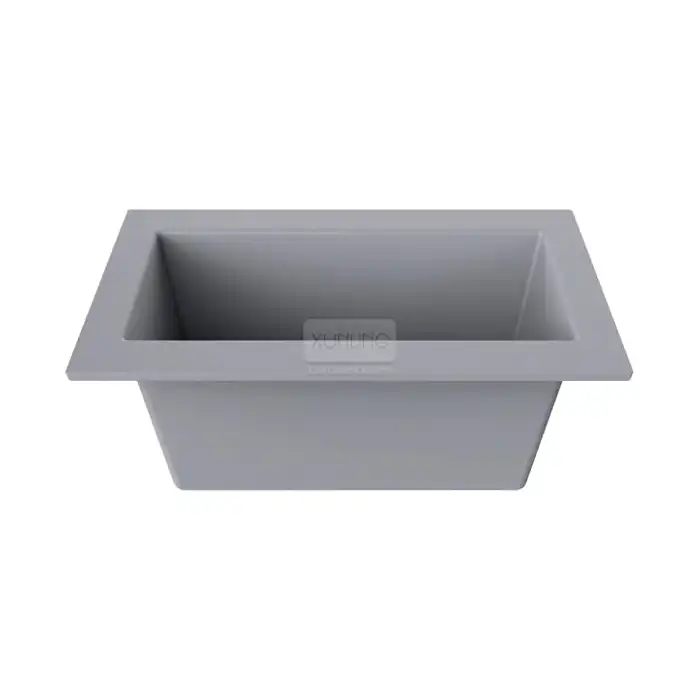
_1735392842145.webp)
